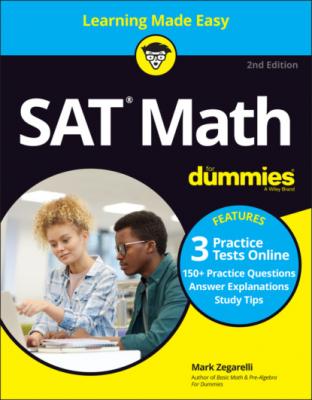SAT Math For Dummies with Online Practice. Mark Zegarelli
Чтение книги онлайн.
Читать онлайн книгу SAT Math For Dummies with Online Practice - Mark Zegarelli страница 11
 quadratic functions using standard, vertex, and factored forms (Chapter 12)
quadratic functions using standard, vertex, and factored forms (Chapter 12)
Graphing exponential and radical equations (Chapter 13)
Solving problems using basic geometry and trigonometry (Chapter 14)
Working with complex numbers and circles on the xy-plane (Chapter 15)
I provide this information in Part 4.
SAT Math Strategy
When it comes to doing well on the SAT, your test-taking strategy is a small but important piece of the puzzle. And this strategy also extends to knowing which questions to answer and which to skip, depending on the score you’re currently striving for.
In this section, I fill you in on this essential information.
Isn’t there some way to get a good SAT Math score without actually knowing math?
No.
I’d love to tell you otherwise, but no.
If the key to getting a great score were, say, choosing Answer C on every question, the name of this book would be Answer C Math For Dummies and it would be a lot shorter.
While you fully absorb that difficult truth, I will add that there’s a reasonable amount of strategy you should absolutely know before taking your first SAT. And while you may think that lots of students already know this stuff, plenty of others don’t — yet.
I don’t want you to be one of them.
So read on.
Is there a penalty for guessing?
If you have an older brother or sister who took the SAT before 2016, they may remember the old format, which had a penalty for filling in a wrong answer.
So please take note: The SAT in its current form has no penalty for filling in a wrong answer. This goes for all four sections, the English as well as the math sections.
Obviously, then, you want to make sure that you fill in at least some answer for each multiple-choice question on the two math sections. That’s 45 questions, so by pure chance, you can expect to get about 11 questions right just by making wild guesses.
Let’s take that thinking a step further: If you don’t fill guesses for all the questions you don’t have time to think about, you’ll be competing against a ton of other students who are guessing. So, bottom line, you can’t afford not to guess every question you don’t know the answer to.
What about the gridded-response questions? Well, because these questions are entirely open ended, you don’t have much chance of answering them correctly with a wild guess. But if you have any idea what the answer might be, go ahead and grid it in. Worst case, doing this won’t lose you any points.
Are some questions harder than others?
Generally speaking, SAT Math questions fall into three categories of difficulty: easy, medium, and hard.
In both the No Calculator and Calculator sections of the test, the multiple-choice questions are roughly in order from easy, to medium, to hard. And then this pattern repeats, with the shorter grid-in question section also progressing from easy, to medium, to hard.
Table 1-1 shows the rough breakdown of questions by difficulty levels.
TABLE 1-1 Easy, Medium, and Hard Questions
| Section 3 — No Calculator | Section 4 — Calculator | ||||
|---|---|---|---|---|---|
| Question Type | Question Number | Difficulty Level | Question Type | Question Number | Difficulty Level |
| Multiple Choice | 1-5 | Easy | Multiple Choice | 1-10 | Easy |
| 6-10 | Medium | 11-20 | Medium | ||
| 11-15 | Hard | 20-30 | Hard | ||
| Grid-In | 16-17 | Easy | Grid-In | 31-33 | Easy |
| 18 | Medium | 34-35 | Medium | ||
| 19-20 | Hard | 36-38 | Hard |
Remember that every question counts for one point toward your raw score, which directly affects your scaled score (200–800). So, unlike the tests you take in school, the easiest and hardest questions on the SAT both have the same value.
Do I have to answer every question?
The short answer is, no, you don’t have to answer every SAT math question to get a good score.
In fact, depending on your current performance level on practice tests, it may very well be to your benefit not to answer all the questions.
This piece of strategy definitely goes against a lot of your training as a high school student. After all, in most of your classes, you can’t get an A or even a B on a test without answering just about all the questions. If you only answer 75 percent and skip the rest, even if you answer perfectly, probably the best you can hope for is a C.
However, the situation with the SAT is entirely different.
On the SAT, you can get a 500 math score by answering only about 55 percent of the questions on the test correctly.
I dive more deeply into this